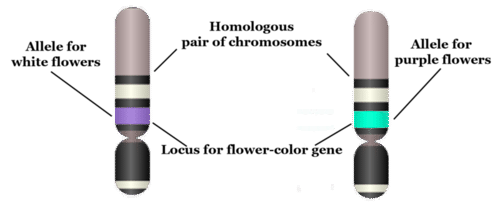8.2 Genetics

This father-son duo share some similarities. The shape of their faces and their facial features look very similar. You might guess they are father and son if you saw them together. People have long known that the characteristics of living things are similar between parents and their offspring. However, it wasn’t until the experiments of Gregor Mendel that scientists understood how those traits are inherited.
The Father of Genetics
Mendel experimented with pea plants to show how traits such as seed shape and flower colour are inherited. Based on his research, he developed two well-known laws of inheritance: the law of segregation and the law of independent assortment. When Mendel died in 1884, his work was still virtually unknown. In 1900, three other researchers working independently came to the same conclusions Mendel had drawn almost half a century earlier. Only then was Mendel’s work rediscovered.
Mendel knew nothing about genes because they were discovered after his death. However, he thought that some “factors” controlled traits and that those “factors” were passed from parents to offspring. We now call these “factors” genes. Mendel’s laws of inheritance, now expressed in terms of genes, form the basis of genetics, the science of heredity. For this reason, Mendel is often called the father of genetics.
The Language of Genetics
Today, we know that genes on chromosomes control the traits of organisms. To talk about inheritance in terms of genes and chromosomes, you need to know the language of genetics. The terms below serve as a good starting point. They are illustrated in the figure that follows.
- A gene is the part of a chromosome containing a given protein’s genetic code. For example, in pea plants, a given gene might code for flower colour.
- The position of a given gene on a chromosome is called its locus (plural, loci). A gene might be located near the centre or at one end or the other of a chromosome.
- A given gene may have different normal versions, which are called alleles. For example, in pea plants, there is a purple-flower allele (P) and a white-flower allele (p) for the flower-colour gene. Different alleles account for much of the variation in the traits of organisms, including people.
- In sexually reproducing organisms, each individual has two copies of each type of chromosome. Paired chromosomes of the same type are called homologous chromosomes. They are about the same size and shape and have all the same genes at the same loci.

Figure 8.2.2 Description
A diagram comparing two homologous chromosomes to show allele differences. The left chromosome has a purple band representing a recessive allele (a), and the right chromosome has a teal band representing a dominant allele (A). Each allele is located in the same position (locus) on the chromosome pair, highlighting how different versions of a gene (alleles) can exist at the exact location on homologous chromosomes.
Genotype
When sexual reproduction occurs, sex cells (gametes) unite during fertilization to form a single cell called a zygote. The zygote inherits two of each type of chromosome, with one of each type coming from the father and the other from the mother. Because homologous chromosomes have the same genes at the same loci, each individual also inherits two copies of each gene. The two copies may be the same allele or different alleles. The alleles an individual inherits for a given gene make up the individual’s genotype. As shown in Table 8.2.1, an organism with two of the same allele (for example, PP or pp) is called a homozygote. An organism with two different alleles (in this example, Pp) is called a heterozygote.
Phenotype
The expression of an organism’s genotype is referred to as its phenotype, and it refers to the organism’s traits, such as purple or white flowers in pea plants. As you can see from Table 8.2.1, different genotypes may produce the same phenotype. In this example, both PP and Pp genotypes produce plants with the same phenotype, purple flowers. Why does this happen? Only the P allele is expressed in a Pp heterozygote, so the p allele doesn’t influence the phenotype. Generally, when only one of two alleles is expressed in the phenotype, the expressed allele is called dominant, and the allele that isn’t expressed is called recessive.
The terms dominant and recessive may also be used to refer to phenotypic traits. For example, purple flower colour in pea plants is a dominant trait. It shows up in the phenotype whenever a plant inherits even one dominant allele for the trait. Similarly, white flower colour is a recessive trait. Like other recessive traits, it shows up in the phenotype only when a plant inherits two recessive alleles for the trait.
|
Alleles |
Genotype |
Phenotype |
|---|---|---|
| PP | Homozygous dominant | Purple flowers |
| Pp | Heterozygous | Purple flowers |
| pp | Homozygous recessive | White flowers |
Exercise 8.2.1
Text Description
1. The term ____ is used to mean the part of a chromosome that contains the genetic code for a specific protein.
You have two copies of each type of gene, called ____, which are present on 2 chromosomes that code for the same types of traits, called ____.
The specific area on a chromosome that you might find a gene is called a ____.
The two alleles you have determines your ____, which in turn determines what your observable characteristics are, are referred to as ____.
Possible Answers:
- alleles
- locus
- phenotype
- gene
- homologous chromosomes
- genotype
2. If a child has the genotype Dd and he/she inherited the D from their mother, where did the d likely come from?
- Thier Moter
- Their maternal grandparents
- Either their mother or their father
- Their Father
3. A gene for flower colour and a gene for seed shape could be on the same:
- Locus
- Chromosome
- Allele
- All of the above
4. Each phenotype has only one genotype. (True/False)
5. Recessive genes are never expressed in a phenotype. (True/False)
6. An observable physical trait is a phenotype. (True/False
7. A gene usually codes for a given
- Allele
- Protein
- Chromosome
- Amino Acid
Answers
1. The term gene is used to mean the part of a chromosome that contains the genetic code for a specific protein.
You have two copies of each type of gene, called alleles, which are present on 2 chromosomes that code for the same types of traits, called homologous chromosomes.
The specific area on a chromosome that you might find a gene is called a locus.
The two alleles you have determines your genotype, which in turn determines what your observable characteristics are, are referred to as phenotype.
2. Their father
3. Chromosome
4. False
5. False
6. True
7. Protein
“5.11 Genetics of Inheritance” from Human Biology by Christine Miller is licensed under a Creative Commons Attribution-NonCommercial 4.0 International License, except where otherwise noted.

